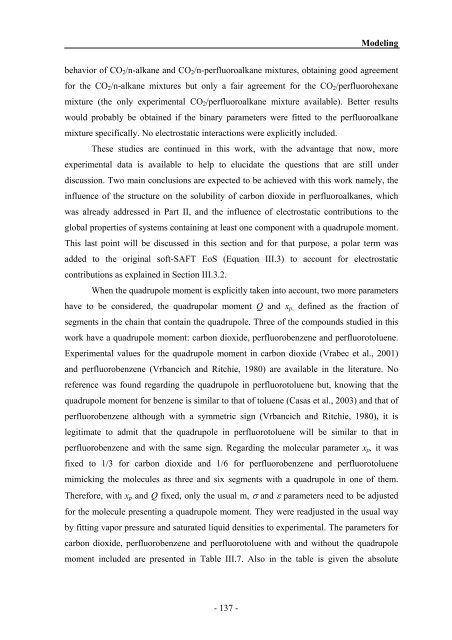n - PATh :.: Process and Product Applied Thermodynamics research ...
n - PATh :.: Process and Product Applied Thermodynamics research ...
n - PATh :.: Process and Product Applied Thermodynamics research ...
You also want an ePaper? Increase the reach of your titles
YUMPU automatically turns print PDFs into web optimized ePapers that Google loves.
Modeling<br />
behavior of CO2/n-alkane <strong>and</strong> CO2/n-perfluoroalkane mixtures, obtaining good agreement<br />
for the CO2/n-alkane mixtures but only a fair agreement for the CO2/perfluorohexane<br />
mixture (the only experimental CO2/perfluoroalkane mixture available). Better results<br />
would probably be obtained if the binary parameters were fitted to the perfluoroalkane<br />
mixture specifically. No electrostatic interactions were explicitly included.<br />
These studies are continued in this work, with the advantage that now, more<br />
experimental data is available to help to elucidate the questions that are still under<br />
discussion. Two main conclusions are expected to be achieved with this work namely, the<br />
influence of the structure on the solubility of carbon dioxide in perfluoroalkanes, which<br />
was already addressed in Part II, <strong>and</strong> the influence of electrostatic contributions to the<br />
global properties of systems containing at least one component with a quadrupole moment.<br />
This last point will be discussed in this section <strong>and</strong> for that purpose, a polar term was<br />
added to the original soft-SAFT EoS (Equation III.3) to account for electrostatic<br />
contributions as explained in Section III.3.2.<br />
When the quadrupole moment is explicitly taken into account, two more parameters<br />
have to be considered, the quadrupolar moment Q <strong>and</strong> xp, defined as the fraction of<br />
segments in the chain that contain the quadrupole. Three of the compounds studied in this<br />
work have a quadrupole moment: carbon dioxide, perfluorobenzene <strong>and</strong> perfluorotoluene.<br />
Experimental values for the quadrupole moment in carbon dioxide (Vrabec et al., 2001)<br />
<strong>and</strong> perfluorobenzene (Vrbancich <strong>and</strong> Ritchie, 1980) are available in the literature. No<br />
reference was found regarding the quadrupole in perfluorotoluene but, knowing that the<br />
quadrupole moment for benzene is similar to that of toluene (Casas et al., 2003) <strong>and</strong> that of<br />
perfluorobenzene although with a symmetric sign (Vrbancich <strong>and</strong> Ritchie, 1980), it is<br />
legitimate to admit that the quadrupole in perfluorotoluene will be similar to that in<br />
perfluorobenzene <strong>and</strong> with the same sign. Regarding the molecular parameter xp, it was<br />
fixed to 1/3 for carbon dioxide <strong>and</strong> 1/6 for perfluorobenzene <strong>and</strong> perfluorotoluene<br />
mimicking the molecules as three <strong>and</strong> six segments with a quadrupole in one of them.<br />
Therefore, with xp <strong>and</strong> Q fixed, only the usual m, σ <strong>and</strong> ε parameters need to be adjusted<br />
for the molecule presenting a quadrupole moment. They were readjusted in the usual way<br />
by fitting vapor pressure <strong>and</strong> saturated liquid densities to experimental. The parameters for<br />
carbon dioxide, perfluorobenzene <strong>and</strong> perfluorotoluene with <strong>and</strong> without the quadrupole<br />
moment included are presented in Table III.7. Also in the table is given the absolute<br />
- 137 -



